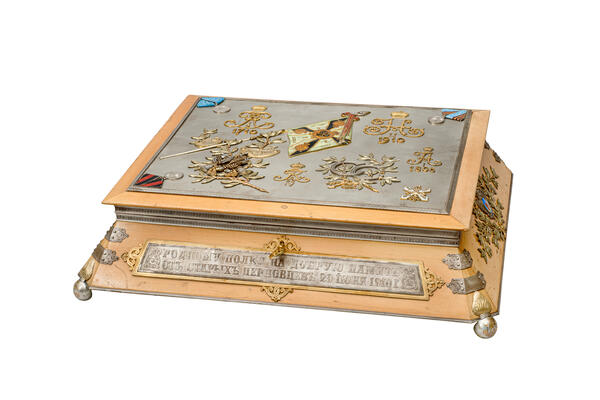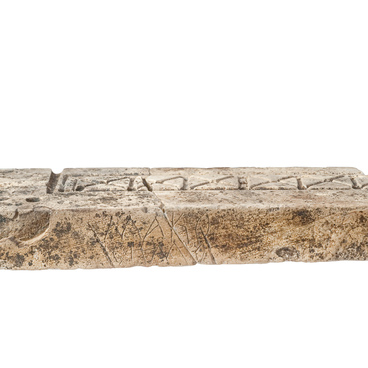This wooden chest with silver onlay ornaments was made by the jewelry factory of Pavel Ovchinnikov in 1910. It was commissioned as a gift for the 200th anniversary of the Third Grenadier Pernau Regiment that was established on July 29, 1710. The valuable gift was presented by former field and company officers of the regiment. The inner side of the lid is engraved with their signatures.
Each detail in the decoration of this chest reflects certain episodes from the history of the Pernau regiment, its military merits and awards. There is a silver plate on the cover with an enamel image of the regimental color in the middle. The pole topper is decorated with an anniversary red ribbon of the Order of Alexander Nevsky which was granted to military units after 100 years of service.
Beside the regimental color there are gilded monograms of Peter the Great, Alexander I and Nicholas II, as well as three dates — 1710, 1806 and 1910. There is also the monogram of Frederick William IV of Prussia — the Pernau regiment used to bear the king’s name until 1914.
The chest’s cover also features laurel branches which symbolize glory. The branches are decorated with two silver trumpets tied with the Ribbon of Saint George — the regiment was presented with these trumpets as a reward for the victory in the Battle of Kars during the Russo-Turkish war of 1877–1878.
In the three corners of the plate there are medals commemorating the regiment’s participation in the Russo-Turkish War, the Defense of Sevastopol and the Patriotic War of 1812. In the right bottom corner there is an image of the officer badge “For distinguished military service”.
Under the keyhole on the front wall there is a silver plate with an engraved inscription that says: “To our beloved regiment from former Pernau officers”. On the back wall there is another plate which lists all the military campaigns in which the regiment had participated in the two centuries of its history, including several Russo-Finnish and Russo-Turkish wars, the January Uprising against Russian rule in Poland, the Great Northern War, the Russo-Persian war and many others. On the side walls there are the coats of arms of Pernau (Pärnu) and Nyslott (Savonlinna) which were gained by the Russian Empire in the Great Northern War.
Each detail in the decoration of this chest reflects certain episodes from the history of the Pernau regiment, its military merits and awards. There is a silver plate on the cover with an enamel image of the regimental color in the middle. The pole topper is decorated with an anniversary red ribbon of the Order of Alexander Nevsky which was granted to military units after 100 years of service.
Beside the regimental color there are gilded monograms of Peter the Great, Alexander I and Nicholas II, as well as three dates — 1710, 1806 and 1910. There is also the monogram of Frederick William IV of Prussia — the Pernau regiment used to bear the king’s name until 1914.
The chest’s cover also features laurel branches which symbolize glory. The branches are decorated with two silver trumpets tied with the Ribbon of Saint George — the regiment was presented with these trumpets as a reward for the victory in the Battle of Kars during the Russo-Turkish war of 1877–1878.
In the three corners of the plate there are medals commemorating the regiment’s participation in the Russo-Turkish War, the Defense of Sevastopol and the Patriotic War of 1812. In the right bottom corner there is an image of the officer badge “For distinguished military service”.
Under the keyhole on the front wall there is a silver plate with an engraved inscription that says: “To our beloved regiment from former Pernau officers”. On the back wall there is another plate which lists all the military campaigns in which the regiment had participated in the two centuries of its history, including several Russo-Finnish and Russo-Turkish wars, the January Uprising against Russian rule in Poland, the Great Northern War, the Russo-Persian war and many others. On the side walls there are the coats of arms of Pernau (Pärnu) and Nyslott (Savonlinna) which were gained by the Russian Empire in the Great Northern War.



